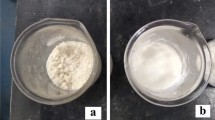Abstract
The insulative character of expanded polystyrene loose-fill packing material supports the immobile triboelectric charge on its surface, causing static cling. One beneficial property of starch-based loose-fill is its antistatic behavior, which prevents the buildup of electrostatic charges on the foam surface, resulting in no static cling. This investigation explores the electrical resistance characteristics of plasticized starch materials such as commercial loose-fill. Electrical resistance standards used in this study to measure surface resistance and static decay properties are ASTM D 257-78, EOS/ESD S-11, and EIA 541. Following these established testing protocols, the electrical resistance of starch-based and expanded polystyrene loose-fill is quantified. Surface resistivity, measured at 12% RH, of starch-based loose-fill products is less than 1.0×1012 Ω per square characteristic of inherently static dissipative materials.
Similar content being viewed by others
References
N. L. Lacourse and P. A. Altieri (1989) U.S. patent 4,863.655.
N. L. Lacourse and P. A. Altieri (1990)Proceedings of the Corn Utilization Conference III, National Corn Growers Association, St. Louis, MO.
J. Afinsenet al. (1992) Expandable and expanded (Foamed) solid products.PCT Int. Appl. WO92, 08.759.
Mitsuo Nagai, Yoshinori Tokugawa, Fumiaki Tsuda, and Hiroshi Iwasaki (1994) in Y. Doi and K. Fukuda (Eds.),Biodegradable Plastics and Polymers, Elsevier Science B.V., Amsterdam, pp. 459–463.
American Heritage Electronic Dictionary (1992) Houghton Mifflin, New York.
K. N. Mathes (1986) in H. F. Mark, N. M. Bikales, C. G. Overberger, and G. Menges (Eds.),Encyclopedia of Polymer Science and Engineering, Vol. 5, John Wiley & Sons, New York, pp. 584–585.
C. C. Ku and R. Liepins (1987)Electrical Properties of Polymers: Chemical Principles, Hanser, New York, p. 5.
B. A. Unger (1986)Quality 25, 14–16.
C. C. Ku and R. Liepins (1987)Electrical Properties of Polymers: Chemical Principles, Hanser, New York, pp. 238–239.
ESD (1983)Standard Test Methods for D-C Resistance or Conductance of Insulating Materials, ASTM D 257-78, American Society for Testing & Materials, Philadelphia, PA, pp. 74–89.
ESD (1993)Surface Resistance Measurement of Static Dissipative Planar Materials, EOS/ESD S11.11-1993, ESD Association, Rome, New York.
EIA (1988)Packaging Material Standards for ESD Sensitive Items, EIA Standard 541, Electronic Industries Association, Washington, DC.
G. Baumgartner (1987)EOS/ESD Symposium, 9, ESD Association, Rome, New York, pp. 18–27.
B. N. Stevens (1986)EOS/ESD Symposium, 8, ESD Association, Rome, New York, pp. 148–149.
S. Weitz (1993)EMC Test and Design.
Monroe Electronics, Inc. (1991) Operator's Manual:Model 272 Portable Surface Resistivity/Resistance Meter, Lydonville, NY, Oct.
N. S. Rubin (1993)EE-Evaluation Engineering.
ESD (1994)ESD Association Advisory for Electrostatic Discharge Terminology Glossary, ESD Association, Rome, New York.
Electro-Tech Systems, Inc. (1994) Product Brochure:Model 406D Static Decay Meter, Glenside, PA, Oct.
Electro-Tech Systems, Inc. (1994) Product Brochure:Model 518 Automatically Controlled Environmental Chamber, Glenside, PA, May.
Mettler-Toledo Inc. (1994) Operating Instructions:Model DL35 Karl Fisher Titrator, Hightstown, NJ.
Mettler-Toledo Inc. (1990) Operating Instructions:Model DO301 Drying Oven, Hightstown, NJ.
R. A. Reck (1986) In H. F. Mark, N. M. Bikales, C. G. Overberger, and G. Menges (Eds.),Encyclopedia of Polymer Science and Engineering, Vol. 2, John Wiley & Sons, New York, pp. 99–115.
J. T. McClave and P. G. Benson (1991)Statistics for Business and Economics, Dellen, San Francisco, pp. 272, 402–407.
P. D. Tatarka (1995)Proceedings of the SPE 53rd Annual Technical Conference, 41, Society of Plastics Engineers, Brookfield, CT, pp. 2225–2231.
D. Trimmel, C. L. Swanson, and G. F. Fanta (1993)J. Appl. Polym. Sci. 48, 1665–1675.
J. M. Crosby and C. S. Adams (1987)EOS/ESD Symp. 9, 28–35.
J. A. Bradford (1993)EOS/ESD Symp. 15, 201–207.
S. E. Shelton (1982)Best's Safety Directory.
Author information
Authors and Affiliations
Additional information
Names are necessary to report factually on available data; however, the USDA neither guarantees nor warrants the standard of the product, and the use of the name by the USDA implies no approval of the product to the exclusion of others that may be suitable.
Rights and permissions
About this article
Cite this article
Tatarka, P.D. Electrical resistance characteristics of starch foams. J Environ Polym Degr 4, 149–156 (1996). https://doi.org/10.1007/BF02067449
Issue Date:
DOI: https://doi.org/10.1007/BF02067449




